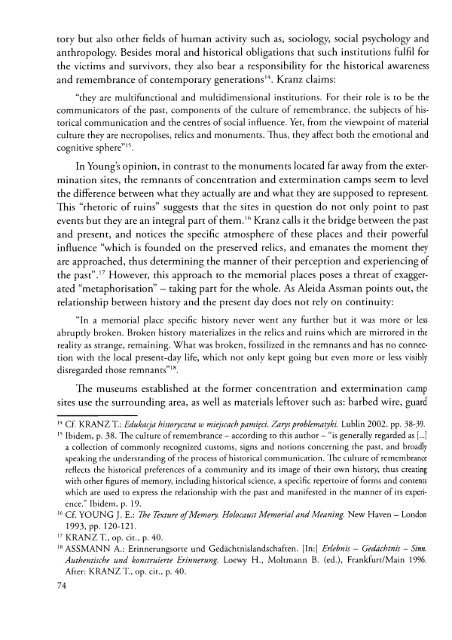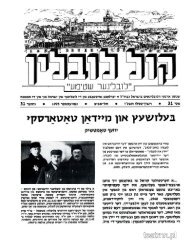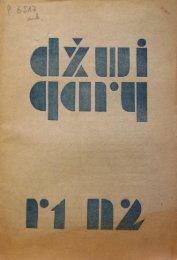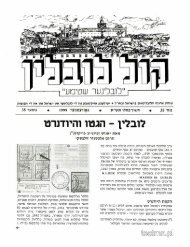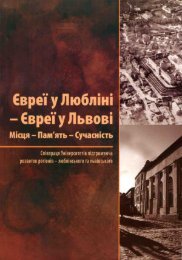The Jews in Lublin - Biblioteka Multimedialna Teatrnn.pl - Brama ...
The Jews in Lublin - Biblioteka Multimedialna Teatrnn.pl - Brama ...
The Jews in Lublin - Biblioteka Multimedialna Teatrnn.pl - Brama ...
You also want an ePaper? Increase the reach of your titles
YUMPU automatically turns print PDFs into web optimized ePapers that Google loves.
tory but also other fields of human activity such as, sociology, social psychology and<br />
anthropology. Besides moral and historical obligations that such <strong>in</strong>stitutions fulfil for<br />
the victims and survivors, they also bear a responsibility for the historical awareness<br />
and remembrance of contemporary generations 14 . Kranz claims:<br />
"they are multifunctional and multidimensional <strong>in</strong>stitutions. For their role is to be the<br />
communicators of the past, components of the culture of remembrance, the subjects of historical<br />
communication and the centres of social <strong>in</strong>fluence. Yet, from the viewpo<strong>in</strong>t of material<br />
culture they are necropolises, relics and monuments. Thus, they affect both the emotional and<br />
cognitive sphere" 15 .<br />
In Youngs op<strong>in</strong>ion, <strong>in</strong> contrast to the monuments located far away from the exterm<strong>in</strong>ation<br />
sites, the remnants of concentration and exterm<strong>in</strong>ation camps seem to level<br />
the difference between what they actually are and what they are supposed to represent.<br />
This "rhetoric of ru<strong>in</strong>s" suggests that the sites <strong>in</strong> question do not only po<strong>in</strong>t to past<br />
events but they are an <strong>in</strong>tegral part of them. 16 Kranz calls it the bridge between the past<br />
and present, and notices the specific atmosphere of these <strong>pl</strong>aces and their powerful<br />
<strong>in</strong>fluence "which is founded on the preserved relics, and emanates the moment they<br />
are approached, thus determ<strong>in</strong><strong>in</strong>g the manner of their perception and experienc<strong>in</strong>g of<br />
the past". 17 However, this approach to the memorial <strong>pl</strong>aces poses a threat of exaggerated<br />
"metaphorisation" - tak<strong>in</strong>g part for the whole. As Aleida Assman po<strong>in</strong>ts out, the<br />
relationship between history and the present day does not rely on cont<strong>in</strong>uity:<br />
"In a memorial <strong>pl</strong>ace specific history never went any further but it was more or less<br />
abruptly broken. Broken history materializes <strong>in</strong> the relics and ru<strong>in</strong>s which are mirrored <strong>in</strong> the<br />
reality as strange, rema<strong>in</strong><strong>in</strong>g. What was broken, fossilized <strong>in</strong> the remnants and has no connection<br />
with the local present-day life, which not only kept go<strong>in</strong>g but even more or less visibly<br />
disregarded those remnants" 18 .<br />
<strong>The</strong> museums established at the former concentration and exterm<strong>in</strong>ation camp<br />
sites use the surround<strong>in</strong>g area, as well as materials leftover such as: barbed wire, guard<br />
14<br />
Cf. KRANZ T.: Edukacja historyczna w miejscach pamięci. Zarys problematyki. Lubl<strong>in</strong> 2002, pp. 38-39.<br />
15<br />
Ibidem, p. 38. <strong>The</strong> culture of remembrance - accord<strong>in</strong>g to this author - "is generally regarded as [...]<br />
a collection of commonly recognized customs, signs and notions concern<strong>in</strong>g the past, and broadly<br />
speak<strong>in</strong>g the understand<strong>in</strong>g of the process of historical communication. <strong>The</strong> culture of remembrance<br />
reflects the historical preferences of a community and its image of their own history, thus creat<strong>in</strong>g<br />
with other figures of memory, <strong>in</strong>clud<strong>in</strong>g historical science, a specific repertoire of forms and contents<br />
which are used to express the relationship with the past and manifested <strong>in</strong> the manner of its experience."<br />
Ibidem, p. 19.<br />
16<br />
Cf. YOUNG J. E.: <strong>The</strong> Texture of Memory. Holocaust Memorial and Mean<strong>in</strong>g. New Haven - London<br />
1993, pp. 120-121.<br />
17<br />
KRANZ T., op. cit., p. 40.<br />
18<br />
ASSMANN A.: Er<strong>in</strong>nerungsorte und Gedachtnislandschaften. [In:] Erlebnis — Gedachtnis - S<strong>in</strong>n.<br />
Authentische und konstruierte Er<strong>in</strong>nerung. Loewy H., Moltmann B. (ed.), Frankfurt/Ma<strong>in</strong> 1996.<br />
After: KRANZ T., op. cit., p. 40.<br />
74


